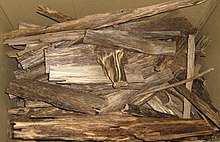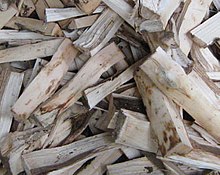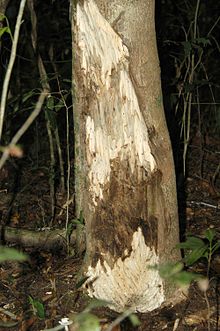Agarwood

Agarwood,aloeswood,eaglewood,gharuwoodor theWood of Gods,most commonly referred to asoudoroudh(fromArabic:عود,romanized:ʿūd,pronounced[ʕuːd]), is a fragrant, dark andresinouswoodused inincense,perfume, and smallhand carvings.It forms in theheartwoodofAquilariatrees after they become infected with a type ofPhaeoacremoniummold,P. parasitica.The tree defensively secretes a resin to combat the fungal infestation. Prior to becoming infected, the heartwood mostly lacks scent, and is relatively light and pale in colouration. However, as the infection advances and the tree produces its fragrant resin as a final option of defense, the heartwood becomes very dense, dark, and saturated with resin. This product is harvested, and most famously referred to incosmeticsunder the scent names ofoud,oodhoraguru;however, it is also calledaloes(not to be confused with thesucculent plantgenusAloe),agar(this name, as well, is not to be confused with the edible,algae-derived thickening agentagar agar), as well asgaharuorjinko.With thousands of years of known use, and valued acrossMuslim,Christian,andHinducommunities (among other religious groups), oud is prized in Middle Eastern and South Asian cultures for its distinctive fragrance, utilized incolognes,incenseandperfumes.

One of the main reasons for the relative rarity and high cost of agarwood is the depletion of the wild resource.[1]Since 1995, theConvention on International Trade in Endangered Species of Wild Fauna and Florahas listedAquilaria malaccensis(the primary source) in itsAppendix II (potentially threatened species).[2]In 2004, allAquilariaspecies were listed in Appendix II; however, a number of countries have outstanding reservations regarding that listing.[2]
The varying aromatic qualities of agarwood are influenced by the species, geographic location, its branch, trunk and root origin, length of time since infection, and methods of harvesting and processing.[3]
Agarwood is one of the most expensive woods in the world, along withAfrican blackwood,sandalwood,pink ivoryandebony.[4][5]First-grade agarwood is one of the most expensive natural raw materials in the world,[6]with 2010 prices for superior pure material as high as US$100,000/kg, although in practice adulteration of the wood and oil is common, allowing for prices as low as US$100/kg.[7]A wide range of qualities and products come to market, varying in quality with geographical location, botanical species, the age of the specific tree, cultural deposition and the section of the tree where the piece of agarwood stems from.[8]As of 2013[update]the global market for agarwood had an estimated value of US$6 to 8 billion and was growing rapidly.[9]
Denomination
[edit]Etymology
[edit]The word ultimately comes from one of theDravidianlanguages,[10][11]probably from Tamil அகில் (agil).[12]
Vernacular names
[edit]
Agarwood is known under many names in different cultures:
- Another name isLignum aloesor Aloeswood, unrelated to the familiar genus,Aloe.Also fromaghil,via Hebrew and Greek.[13]
- InAssameseit is calledxasi(সাঁচি).[14]
- InBengali,agarwood is known asagor gach (আগর গাছ)and the agarwood oil asagor ator (আগর আতর).
- InOdia,it is calledagara(ଅଗର).
- InMalayalam,it is calledakil(അകിൽ).
- In Cambodia, it is calledchann crassna.The fragrance from this wood is calledkhloem chann(ខ្លឹមចាន់) orkhloem chann crassna.khloemis 'hard wood' andchann crassnais the tree speciesAquilaria crassnain the Khmer language.
- InHindi,it is known asagar,which is derived originally from theSanskritaguru.[15][16]
- InSinhalaAgarwood producingGyrinops wallatree is known as "Walla Patta" (වල්ල පට්ට).
- InTamilit is calledaghi(அகில்) though what was referred in ancient Tamil literature could well beExcoecaria agallocha.
- InTeluguandKannada,it is known by the same Sanskrit name asAguru.
- It is known asChénxiāng(Trầm hương) inChinese,Chimhyang(침향) inKorean,Jinkō(Thẩm hương) inJapanese,andtrầm hươnginVietnamese;all meaning "deep scent" and alluding to its intense scent. In Japan, there are several grades ofJinkō,the highest of which is known asKyara( già la ).[17][18]InVietnam,ancient texts also refer to the use of agarwood in relation to travelling Buddhist monks.[19]
- InTibetanit is known as ཨ་ག་རུ་ (a-ga-ru). There are several varieties used inTibetan Medicine:unique eaglewood, yellow eaglewood: ཨ་ག་རུ་སེར་པོ་ (a-ga-ru ser-po), white eaglewood: ཨར་སྐྱ་ (ar-skya), and black eaglewood: ཨར་ནག་(ar-nag).[20][21]
- Both agarwood and its resin distillate/extracts are known asoud(عود) inArabic(literally "rod/stick" ) and used to describe agarwood in Arab countries.[22]Western perfumers also often use agarwood essential oil under the name "oud" or "oudh".[23]
- In Europe it was referred to asLignum aquila(eagle-wood) orAgilawood,from similarity to Tamil-Malayalamaghil.
- InIndonesianandMalay,it is calledgaharu.
- In ThePhilippines,it is known asLapnisan.
- InPapua New Guineait is called "ghara" or eagle wood.[citation needed]
- InThaiit is known asmai kritsana(ไม้กฤษณา).[24]
- InLaosit is known asmai ketsana(ໄມ້ເກດສະໜາ).[25]
- In Myanmar (Burmese), it is known asThit Mhwae(သစ်မွှေး).
History
[edit]The odour of agarwood is complex and pleasing,[26]with few or no similar natural analogues. In the perfume state, the scent is mainly distinguished by a combination of "oriental-woody" and "very soft fruity-floral" notes. The incense smoke is also characterised by a "sweet-balsamic" note and "shades of vanilla and musk" and amber (not to be confused withambergris).[8]As a result, agarwood and itsessential oilgained great cultural and religious significance in ancient civilizations around the world, being described as a fragrant product as early as 1400 BCE in theVedasofIndia.[27]
In theHebrew Bible,"trees of lign aloes" are mentioned inThe Book of Numbers24:6[28]and a perfume compounded of aloeswood,myrrh,andcassiais described in Psalms 45.[29]
Dioscorides in his book Materia Medica (65 CE) described several medical qualities of agarwood (Áγαλλοχου) and mentioned its use as an incense. Even though Dioscorides describes agarwood as having an astringent and bitter taste, it was used to freshen the breath when chewed or as a decoction held in the mouth. He also writes that a root extract was used to treat stomach complaints and dysentery as well as pains of the lungs and liver.[3]Agarwood's use as a medicinal product was also recorded in theSahih Muslim,which dates back to approximately the ninth century, and in theAyurvedicmedicinal text theSusruta Samhita.[30]
As early as the third century CE in ancient Viet Nam, thechronicleNan zhou yi wu zhi(Strange things from the South) written by Wa Zhen of the EasternWu Dynastymentioned agarwood produced in the Rinan commandery, now CentralVietnam,and how people collected it in the mountains.

During the sixth century CE in Japan, in the recordings of theNihon Shoki(The Chronicles of Japan) the second oldest book of classical Japanese history, mention is made of a large piece of fragrant wood identified as agarwood. The source for this piece of wood is claimed to be fromPursat, Cambodia(based on the smell of the wood). The famous piece of wood still remains in Japan today and is showcased less than 10 times per century at theNara National Museum.
Agarwood is highly revered in Hinduism, Buddhism, Chinese Folk Religion and Islam.[3][31]
Starting in 1580 afterNguyễn Hoàngtook control over the central provinces of modern Vietnam, he encouraged trade with other countries, specifically China and Japan. Agarwood was exported in three varieties: Calambac (kỳ nam in Vietnamese), trầm hương (very similar but slightly harder and slightly more abundant), and agarwood proper. A pound of Calambac bought inHội Anfor 15taelscould be sold inNagasakifor 600 taels. TheNguyễn Lordssoon established aRoyal Monopolyover the sale of Calambac. This monopoly helped fund the Nguyễn state finances during the early years of the Nguyen rule.[32] Accounts of international trade in agarwood date back as early as the thirteenth century, note India being one of the earliest sources of agarwood for foreign markets.[33]
Xuanzang's travelogues and theHarshacharita,written in seventh century AD in Northern India, mentions use of agarwood products such as 'Xasipat' (writing-material) and 'aloe-oil' in ancientAssam(Kamarupa). The tradition of making writing materials from its bark still exists inAssam.
It is to this day still used in traditional Chineseherbal medicinewhere it goes by the name of Chén Xiāng - trầm hương - Literally meaning 'sinking fragrance'. Its earliest recorded mention is from the Miscellaneous Records of Famous Physicians, danh y biệt lục, Ming Yi Bie Lu, ascribed to the author Táo Hǒng-Jǐng c.420-589.[34]
Formation
[edit]Production mode
[edit]There are seventeen species in the genusAquilaria,large evergreens native tosoutheast Asiaandsouth asia,of which nine are known to produce agar wood.[35]Agarwood can in theory be produced from all members, but until recently it was primarily produced fromA. malaccensis(A. agallochaandA. secundariaare synonyms forA. malaccensis).[1]A. crassnaandA. sinensisare the other two members of the genus that are commonly harvested. Thegyrinopstree can also produce agarwood.[36]

Agar wood forms in the trunk and roots of trees that have been penetrated by anAmbrosia beetleinsect feeding on wood and oily resin,Dinoplatypus chevrolati.The tree may then be infected by a mould, and in response will produces a salutary self-defence material to conceal damages or infections. While the unaffected wood of the tree is relatively light in colour, the resin dramatically increases the mass and density of the affected wood, changing its colour from a pale beige to yellow, orange, red, dark brown or black. In natural forests, only about 7 out of 100 Aquilaria trees of the same species are infected and produce aloes/agar wood. A common method in planted forestry is toinoculatetrees with the fungus. It produces a "damage sap" and is referred to as "fake" aloes/agar wood.[35]
Oud oil can be distilled from agar wood using steam; the total yield of oil for 70 kg of wood will not exceed 20 ml.[37][full citation needed]
Composition
[edit]The composition of agarwood oil is exceedingly complex with more than 150 chemical compounds identified.[7]At least 70 of these areterpenoidswhich come in the form ofsesquiterpenesandchromones;nomonoterpeneshave been detected at all. Other common classes of compounds includeagarofurans,cadinanes,eudesmanes,valencanesanderemophilanes,guaianes,prezizanes,vetispiranes,simple volatile aromatic compounds as well as a range of miscellaneous compounds.[7]The exact balance of these materials will vary depending on the age and species of tree as well as the exact details of the oil extraction process.
Perfumery
[edit]Oud has become a popular component in perfumery. Most brands have a creation based on or dedicated to "oud" or an accord of oud created through the use of certain chemical scent components. Few perfume houses use real oud in their creations. This is because oud is very expensive and potent. Oud is generally used as a base note and is traditionally paired with rose. Oud essential oil is available on the internet but care should be taken in choosing the vendor. Due to the fact that oud is such an expensive material there is a big market for diluting oud oil with patchouli or other chemical components.
Oud scent is popular in theMiddle East,theArab world,and inArab culture,where it is used as a traditional aromatic and perfume in many forms. Oud is also one of the reasons why the Arab region developed trade routes in ancient times. Popular amongstMuslims,it has been traditionally used inMosqueswhere the incense chips are burned.[38]
Aquilariaspecies that produce agarwood
[edit]The following species ofAquilariaproduce agarwood:[35]
- Aquilaria acuminata,found in Papua New Guinea, Indonesia & Philippines
- Aquilaria apiculata,found inPhilippines
- Aquilaria baillonil,found in Cambodia and Thailand
- Aquilaria banaensae,found in Vietnam
- Aquilaria beccariana,found inIndonesia
- Aquilaria brachyantha,found in Malaysia
- Aquilaria crassnafound inCambodia,Malaysia,Thailand, Laos andVietnam
- Aquilaria cumingiana,found in Indonesia and Malaysia
- Aquilaria filaria,found inNew Guinea,theMoluccas,andMindanao(Philippines)[39]
- Aquilaria grandiflora,found in China
- Aquilaria hirta,found in Thailand, Indonesia and Malaysia[40]
- Aquilaria khasiana,found in Bangladesh and India.
- Aquilaria malaccensis,found in Indonesia, Malaysia, Laos, Thailand, and India
- Aquilaria microcarpa,found in Indonesia and Malaysia
- Aquilaria rostrata,found in Malaysia
- Aquilaria sinensis,found in China and Laos
- Aquilaria subintegra,found inCambodia,Thailand
* Sri Lankan agarwood is known asWalla Pattaand is of theGyrinops wallaspecies.
Conservation of agarwood-producing species
[edit]Overharvestingandhabitat lossthreatens some populations of agarwood-producing species. Concern over the impact of the global demand for agarwood has thus led to the inclusion of the main taxa onCITESAppendix II, which requires that international trade in agarwood be monitored. Monitoring is conducted by Cambridge-basedTRAFFIC(a jointWWFandIUCNprogramme).[41]CITES also provides that international trade in agarwood be subject to controls designed to ensure that harvest and exports are not to the detriment of the survival of the species in the wild.[42]
In addition, agarwood plantations have been established in a number of countries, and reintroduced into countries such as Malaysia and Sri Lanka as commercial plantation crops.[41]The success of these plantations depends on the stimulation of agarwood production in the trees. Numerous inoculation techniques have been developed, with varying degrees of success.[35]
See also
[edit]- Incense in India
- Sandalwood
- Agalloch,the band named after the agarwood
References
[edit]- ^abBroad, S. (1995) "Agarwood harvesting in Vietnam"TRAFFIC Bulletin15:96
- ^abCITES (25 April 2005) "Notification to the Parties" No. 2005/0025Archived30 September 2007 at theWayback Machine.(PDF). Retrieved on 22 July 2013.
- ^abcLópez-Sampson, Arlene; Page, Tony (20 March 2018)."History of Use and Trade of Agarwood"(PDF).Economic Botany.72:107–129.doi:10.1007/s12231-018-9408-4.ISSN0013-0001.S2CID49875414.
- ^"Top 10 Most Expensive Woods in the World".Salpoente Boutique.18 November 2016.Retrieved19 September2020.
- ^"11 Most Expensive Woods in the World".Ventured.22 July 2020.Retrieved19 September2020.
- ^Andy Ash (27 August 2020)."First-grade agarwood can cost as much as $100,000 per kilogram. Why is it so expensive?".Business Insider.Retrieved17 September2020.
- ^abcNaef, Regula (March 2010). "The volatile and semi-volatile constituents of agarwood, the infected heartwood of Aquilaria species: a review".Flavour and Fragrance Journal.26(2): 73–87.doi:10.1002/ffj.2034.
- ^abDinah Jung,The Value of Agarwood: Reflections upon its use and history in South Yemen,Universitätsbibliothel, Universität Heidelberg, 30 May 2011, (PDF) p. 4.
- ^International Journal of Pharmaceutical and Life Sciences,Archived16 April 2014 at theWayback MachineISSN 2305-0330, Volume 2, Issue 1: January 2013)
- ^Burrow, T., and M. B. Emeneau (1984).A Dravidian etymological dictionary(2 ed.). Oxfordshire: Oxford University Press. p. 4.
Ta. akil (in cpds. akiṛ-) eagle-wood, Aquilaria agallocha; the drug agar obtained from the tree; akku eagle-wood. Ma. akil aloe wood, A. agallocha. Ka. agil the balsam tree which yields bdellium, Amyris agallocha; the dark species of Agallochum; fragrance. Tu. agilů a kind of tree; kari agilů Agallochum. / Cf. Skt. aguru-, agaru-; Pali akalu, akaḷu, agaru, agalu, agaḷu; Turner, CDIAL, no. 49. DED 14.
{{cite book}}:CS1 maint: multiple names: authors list (link) - ^Turner, R. L. (Ralph Lilley), Sir(1962–66).A Comparative Dictionary of the Indo-Aryan Languages.London: Oxford University Press. p. 3.
agaru m.n. ʻ fragrant Aloe -- tree and wood, Aquilaria agallocha ʼ lex., aguru -- R. [← Drav. Mayrhofer EWA i 17 with lit.] Pa. agalu --, aggalu -- m., akalu -- m. ʻ a partic. ointment ʼ; Pk. agaru --, agaluya --, agaru(a) -- m.n. ʻ Aloe -- tree and wood ʼ; K. agara -- kāth ʻ sandal -- wood ʼ; S. agaru m. ʻ aloe ʼ, P. N. agar m., A. B. agaru, Or. agarū, H. agar, agur m.; G. agar, agru n. ʻ aloe or sandal -- wood ʼ; M. agar m.n. ʻ aloe ʼ, Si. ayal (agil ← Tam. akil).
{{cite book}}:CS1 maint: multiple names: authors list (link) - ^Shulman, David(2016).Tamil: A biography.Harvard University Press. pp. 19–20.
We haveahalim[in Hebrew], probably derived directly from Tamilakilrather than from Sanskritaguru,itself a loan from the Tamil (Numbers 24.8; Proverbs 7.17; Song of Songs 4.14; Psalms 45.9--the latter two instances with the feminine plural formahalot.Akil is, we think, native to South India, and it is thus not surprising that the word was borrowed by cultures that imported this plant.
- ^Palmer, A. Smythe (1882)Folk Etymology
- ^Panda, H. (1 January 2009).Aromatic Plants Cultivation, Processing And Uses.National Institute of Industrial Re. p. 182.ISBN978-81-7833-057-0.Retrieved8 October2010.
- ^Pusey, Edward Bouverie (1885)Daniel the Prophet: Nine Lectures, Delivered in the Divinity School of the University of OxfordFunk & Wagnalls, New York,p. 515,OCLC5577227
- ^"Aguru"Archived7 June 2010 at theWayback Machinein Sanskrit Dictionary from Bhaktivedanta VedaBase Network
- ^Morita, Kiyoko (1999).The Book of Incense: Enjoying the Traditional Art of Japanese Scents.Kodansha USA.ISBN978-4770023896.
- ^Thứ Hai (9 April 2006) "kỳ nam và trầm hương" Tuổi Trẻ OnlineArchived15 February 2009 at theWayback Machine.Tuoitre.com.vn. Retrieved on 22 July 2013.
- ^Persoon, G.A. "Agarwood: the life of a wounded tree".IIAS Newsletter.45(2007). IIAS, Leiden: 24–25.
- ^Parfionovitch, Yuri; Dorje, Gyurme and Meyer, Fernand (1992)Tibetan medical paintings: illustrations to the Blue beryl treatise of Sangye Gyamtso (1653–1705)(English edition of Tibetan text & paintings) (2 volumes) Serindia, London,ISBN0-906026-26-1
- ^Aromatics, an encyclopedia.2010. Please note: due to the method of assigning names to medicinal botanicals used in Tibet, it must be considered that woods with similar medicinal properties are named as varieties of the same medicine, and not according to anything akin to the nomenclature of Western botany. Tibetan botanical taxonomy is still in the earliest stage: "white aloeswood" actually refers to the non-aromatic portions of the Indian sandalwood tree; "yellow aloeswood" refers to the scented heartwood of Santalum album. Unique aloeswood is the highest grade ofAquilaria agallocharesin, known in English asAgallochum,while "black aloeswood" is the resin infused wood of the same tree; "brown aloeswood" is the scented wood of severalDalbergiaspecies from India and Bhutan.
{{cite book}}:CS1 maint: postscript (link) - ^Burfield, Tony (2005)"Agarwood Trading"Archived1 April 2010 at theWayback MachineThe Cropwatch Files,Cropwatch
- ^Branch, Nathan (30 May 2009)"Dawn Spencer Hurwitz Oude Arabique (extrait)"Archived6 September 2012 atarchive.today(fashion and fragrance reviews)
- ^"สำนักคุ้มครองภูมิปัญญาฯ"Archived25 August 2011 at theWayback Machine,page 1 (๑), in Thai
- ^Hkum, Seng Hkum N and Maodee, M. (July 2005)"Marketing and Domestication of NTFPs in North Phonsali Three Districts"NPADP Presentation, NTFP MIS Workshop Luangprabang, North Phongsali Alternative Development Project, United Nations Office on Drugs and Crime
- ^International Journal of Pharmaceutical and Life Sciences, ISSN 2305-0330, Volume 2, Issue 1: January 2013)
- ^López-Sampson, Arlene; Page, Tony (1 March 2018)."History of Use and Trade of Agarwood".Economic Botany.72(1): 107–129.doi:10.1007/s12231-018-9408-4.ISSN1874-9364.S2CID255560778.
- ^Numbers 24:6, KJV
- ^Psalms 45: "All thy garments smell of myrrh, and aloes, and cassia, out of the ivory palaces, whereby they have made thee glad."
- ^Barden, Angela; Anak, Noorainie Awang; Mulliken, Teresa; Song, Michael (2000).Heart of the Matter: Agarwood Use and Trade and CITES Implementation forAquilaria malaccensis(PDF).Cambridge, England: Traffic International. p. 7.ISBN978-1-85850-177-2.Archived(PDF)from the original on 23 November 2008.
- ^Furlong, Monica(1986).Zen Effects: the Life of Alan Watts.Houghton Mifflin. p. 196.OCLC13821191.ISBN9780395353448.
- ^Li, Tana (1998)Nguyễn Cochinchina: southern Vietnam in the seventeenth and eighteenth centuries,Southeast Asia Program Publications, Ithaca, New York, p. 79,ISBN0-87727-722-2
- ^Ghosh, Sahana (25 October 2018)."Facing extinction, India's scented agarwood is finding ways to grow in home gardens, polluted fields".scroll.in.
- ^Chinese Herbal Medicine: Materia Medica Revised Edition by Dan Bensky (Author), Andrew Gamble (Compiler),ISBN0939616157
- ^abcdNg, L.T.; Chang Y.S.; Kadir, A.A. (1997). "A review on agar (gaharu) producing Aquilaria species".Journal of Tropical Forest Products.2(2): 272–285.
- ^The genus Gyrinops, is closely related to Aquilaria and in the past all species were considered to belong to Aquilaria.Blanchette, Robert A. (2006)"Cultivated Agarwood – Training programs and Research in Papua New Guinea",Forest Pathology and Wood Microbiology Research Laboratory, Department of Plant Pathology, University of Minnesota
- ^Harris, 1995
- ^"The history and meaning of oud in the Middle East".11 November 2021.
- ^"Aquilaria filaria".Germplasm Resources Information Network.Agricultural Research Service,United States Department of Agriculture.Retrieved22 July2013.
- ^"Aquilaria hirta".Germplasm Resources Information Network.Agricultural Research Service,United States Department of Agriculture.Retrieved22 July2013.
- ^abLim, Teckwyn; Awang Anak, Noorainie (2010).Wood for the Trees: A review of the agarwood (gaharu) trade in Malaysia(PDF).Petaling Jaya: TRAFFIC Southeast Asia. p. 108.
- ^Thompson, I. D.; Lim, T.; Turjaman, M. (2022).Expensive, Exploited and Endangered, A review of the agarwood-producing genera Aquilaria and Gyrinops: CITES considerations, trade patterns, conservation, and management(PDF).Yokohama, Japan: International Tropical Timber Organization (ITTO).
Further reading
[edit]Snelder, Denyse J.; Lasco, Rodel D. (29 September 2008).Smallholder Tree Growing for Rural Development and Environmental Services: Lessons from Asia.シュプリンガー・ジャパン chu thức hội xã. p. 248 ff.ISBN978-1-4020-8260-3.Retrieved8 October2010.
Jung, Dr. Dinah (1 January 2013).The cultural biography of agarwood(PDF).University of Heidelberg: HeiDOK: Journal article: JRAS. pp. 103–125.Retrieved30 October2016.
External links
[edit] Media related toAgarwoodat Wikimedia Commons
Media related toAgarwoodat Wikimedia Commons- Hong Kong Herbariumfactsheet ofAquilaria sinensis(archived 13 August 2005)
- Etymology of agarwood and aloe
- "Sustainable Agarwood Production in Aquilaria Trees"at theUniversity of Minnesota
- Traditional and Medicinal Uses of Aquilaria / AgarwoodThe Cropwatch Files
- expensive material,BusinessInsider; video.
